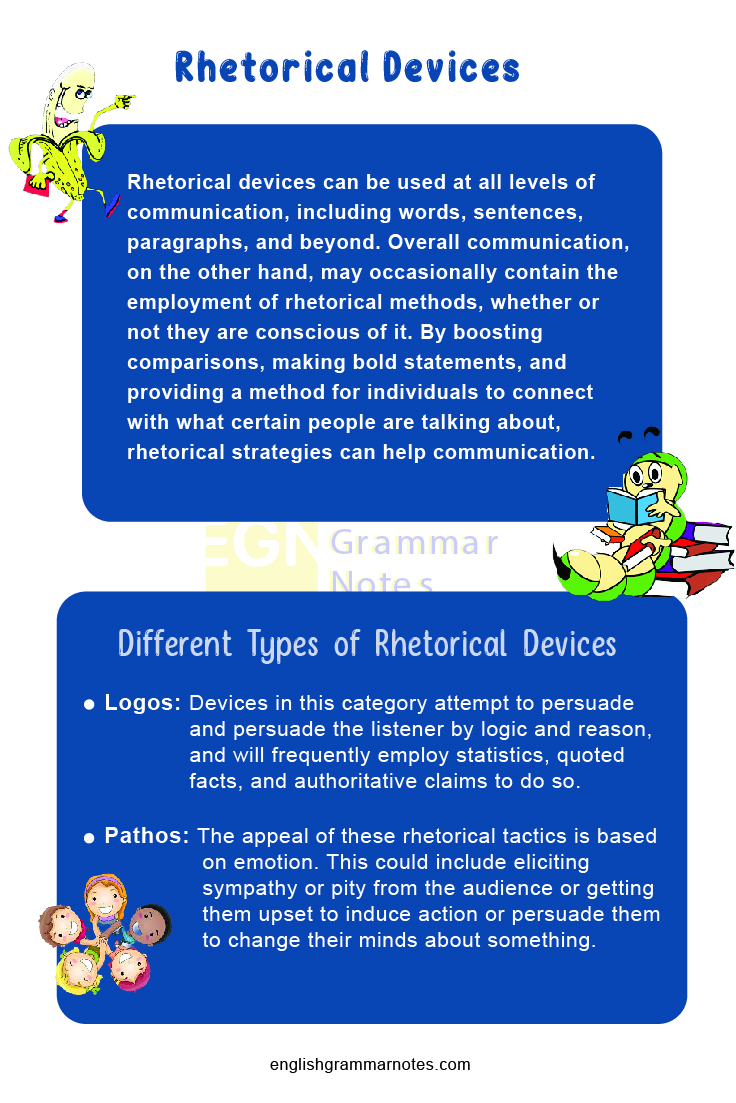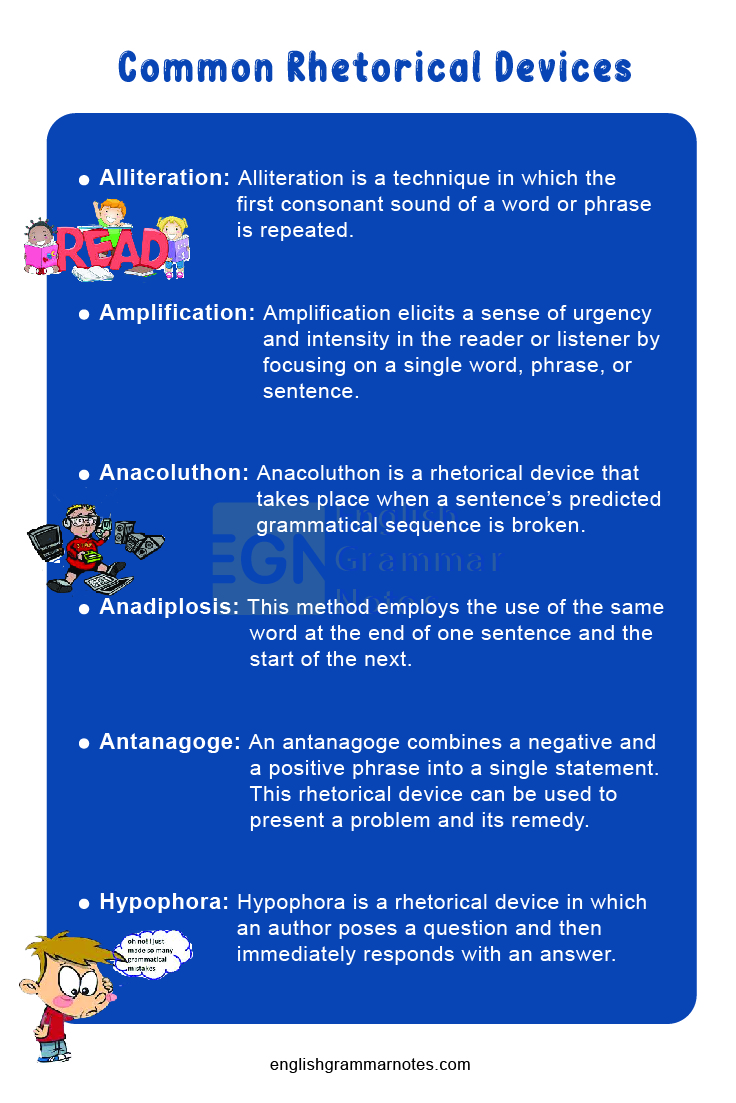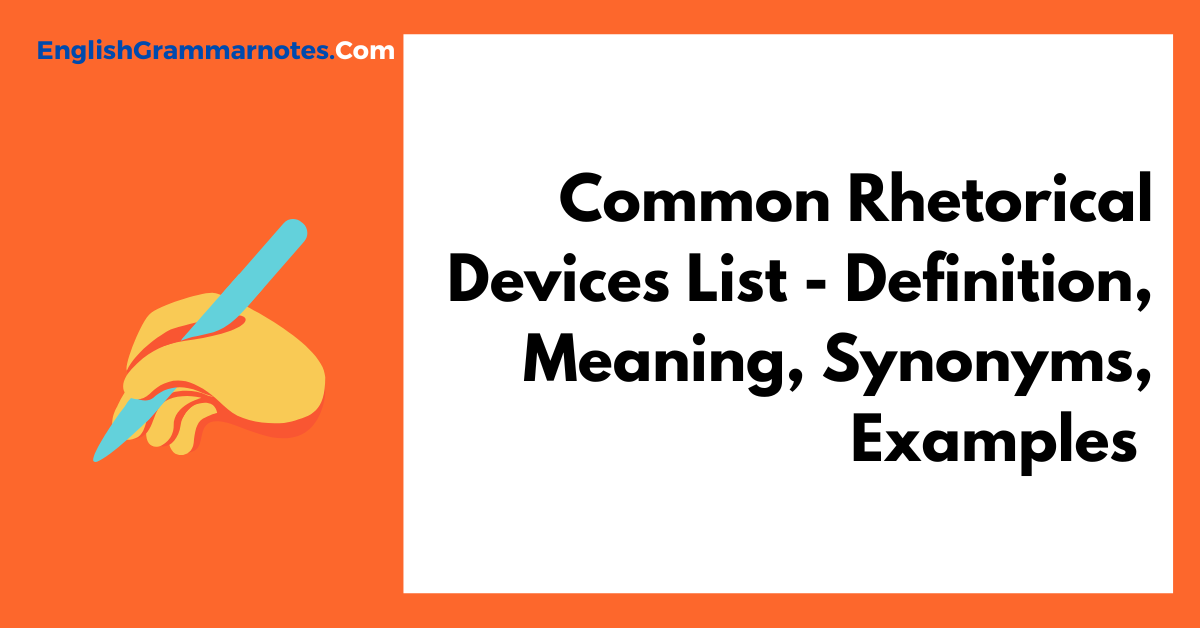A rhetorical device is a piece of words that are used to influence the audience. A rhetorical device is a linguistic instrument that uses a specific sentence structure, tone, or pattern of meaning to elicit a specific response from the audience.
Rhetorical devices include things like repetition, metaphorical language, and even rhetorical questions. Each rhetorical device is a different instrument that can be used to build an argument or strengthen an existing one. In essays, persuasive writing, and even speeches, rhetorical tactics are frequently used.
- Rhetorical Devices Definition
- Different Types of Rhetorical Devices
- Common Rhetorical Devices | Most Useful Rhetorical Devices to Improve your Public Speaking
- What are Rhetorical Devices?
- Is Alliteration a rhetorical Device?
- What impact do literary devices have on the reader?
- What is the purpose of literary devices used by authors?
Rhetorical Devices Definition
Rhetorical devices can be used at all levels of communication, including words, sentences, paragraphs, and beyond. Overall communication, on the other hand, may occasionally contain the employment of rhetorical methods, whether or not they are conscious of it.
By boosting comparisons, making bold statements, and providing a method for individuals to connect with what certain people are talking about, rhetorical strategies can help communication. This article has a summary list of rhetorical methods that you can use to study some of the most regularly utilized devices in both literary and daily speech contexts.
Different Types of Rhetorical Devices
Even though rhetorical and literary methods have a lot in common, there is one fundamental difference between them. While literary elements creatively portray ideas, rhetoric appeals to one’s perceptions in four ways:
- Logos – Devices in this category attempt to persuade and persuade the listener by logic and reason, and will frequently employ statistics, quoted facts, and authoritative claims to do so.
- Pathos – The appeal of these rhetorical tactics is based on emotion. This could include eliciting sympathy or pity from the audience or getting them upset to induce action or persuade them to change their minds about something.
- Ethos – Ethical arguments attempt to persuade the listener that the speaker is a reliable source, that their words carry weight, and that they must be regarded seriously because they are serious and have the expertise and judgment to make the proper decisions.
- Kairos – This is one of the rhetoric’s most complex notions; techniques in this category are based on the notion that a certain idea or action has reached its peak. Part of the argument is that the idea is timely.

See More:
Common Rhetorical Devices | Most Useful Rhetorical Devices to Improve your Public Speaking
Because rhetoric has a long history, much of the vocabulary used to describe it is derived from Greek. Rhetoric, despite its ancient beginnings, is as important as ever. The following is a list of some of the most crucial rhetorical devices to be aware of:
Alliteration
Alliteration is a technique in which the first consonant sound of a word or phrase is repeated. To portray a sense of lyricism, the consonant sound is repeated for most or all of the words. Contrary to consonance, which is the repetition of consonants anywhere in consecutive words, this usually means repeating consonants at the beginning of multiple words.
Amplification
Amplification elicits a sense of urgency and intensity in the reader or listener by focusing on a single word, phrase, or sentence. The goal is to make the statement or sentence more readable and valuable.
It’s usually used when a simple sentence is too abrupt to convey the intended meaning. Writers then use amplification to add structural elements and give additional meaning to a statement by describing and reiterating it.
Anacoluthon
Anacoluthon is a rhetorical device that takes place when a sentence’s predicted grammatical sequence is broken. Instead, the grammatical flow is broken in order to begin a new sentence. The word “anakolouthos” comes from the Greek word “anakolouthos,” which means “lacking sequence.”
Intentionally or unintentionally, this device can be used. In the middle of a phrase, an anacoluthon is used to introduce a rapid change in thoughts or sometimes seemingly unrelated issues. This approach is frequently employed to emphasize the ideas or topics being discussed in a conversation.
Anadiplosis
This method employs the use of the same word at the end of one sentence and the start of the next. When used in this way, anadiplosis permits a chain of thought to continue to the next notion, allowing your audience to follow along with your point. The audience can follow the route of your ideas if you use a repeating technique.
Antanagoge
An antanagoge combines a negative and a positive phrase into a single statement. This rhetorical device can be used to present a problem and its remedy. This tactic, when implemented correctly, can result in a well-developed and convincing approach to communicating, whether in writing or regular speech.
Hypophora
Hypophora is a rhetorical device in which an author poses a question and then immediately responds with an answer. In most cases, the first paragraph poses a question, which is then answered in the second paragraph. “Antipophora” or “anthypophora” are other names for it. When a writer or speaker asks a question and then answers it right away, this rhetorical tactic is applied.
Similies
These devices work by creating a feeling of similarity between two participants. Similes are analogies that are used to convey a similar point of view on a well-known topic. This is a common literary device used by well-known authors such as William Shakespeare.

FAQ’s on Rhetorical Devices PDF
1. What are Rhetorical Devices?
Rhetorical devices are devices employed by authors to allude to greater themes, ideas, and significance in a tale or piece of writing.
2. Is Alliteration a rhetorical Device?
Alliteration is, in fact, a rhetorical device.
3. What impact do literary devices have on the reader?
Rhetorical devices are commonly used by writers to achieve a specific effect in their writing and thus aid readers in comprehending the text on a deeper level.
4. What is the purpose of literary devices used by authors?
Both rhetorical and literary devices can help you improve your writing and communication. Rhetorical devices can help authors write better, no matter what style of writing their doing.
Conclusion
Rhetorical devices are techniques that enable a writer to convey a deeper meaning beyond what appears on the page. There are many different types of literary devices, each with its own function. Some work at the sentence level, while others benefit the entire piece of writing. Writers frequently employ multiple literary devices at the same time. Along with plot and characters, literary devices enhance a story and what it means to people.
